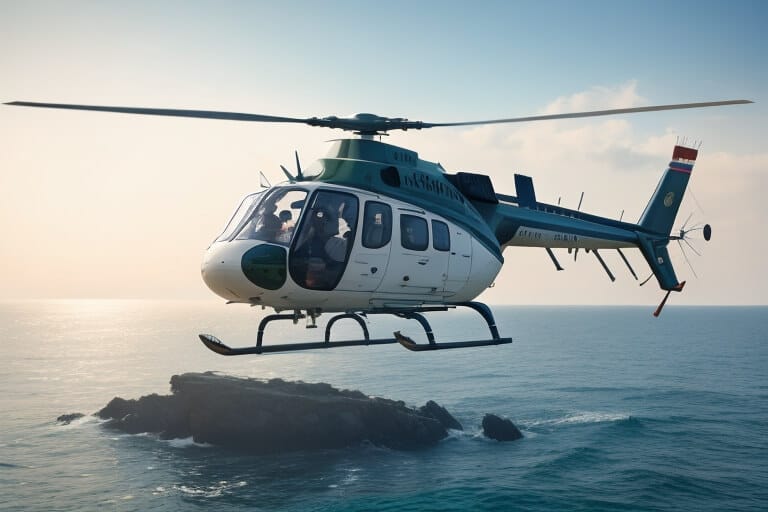
- October 3, 2023
- allix
- Research
Mastering the technique of landing a helicopter on the deck of a ship is a formidable task, especially for Navy pilots. Unlike a conventional runway, a ship’s landing area is compact and constantly in motion due to the sway of the sea. Various attempts have been made to automate ship landings, but none have effectively addressed the unique challenges faced by helicopter pilots, such as gusty winds, low visibility, and other demanding conditions that nature can throw at them.
To tackle this problem, the U.S. Navy is embarking on a mission to develop cutting-edge fully autonomous Vertical Takeoff and Landing (VTOL) aircraft, specifically designed to adapt seamlessly to these adverse conditions. Collaborating with researchers from Texas A&M University, this initiative combines an optimized aircraft design with a robust machine learning algorithm, introducing a novel approach to automating aircraft landings on ships in rough seas.
Dr. Moble Benedict, an associate professor in the Department of Aerospace Engineering at Texas A&M and the project’s principal investigator (PI), explained, “When a helicopter pilot attempts to land on a ship’s deck, their gaze is not fixed on the moving deck itself. Looking directly at the deck can disorient the pilot. Instead, they rely on specialized equipment called the horizon bar, a green, lighted, gyro-stabilized strip that provides them with an artificial horizon.”
While recent studies have focused on tracking the ship’s deck using cameras, GPS, and lidar to match the aircraft’s motion, Benedict and Dr. Dileep Kalathil, an assistant professor in the Department of Electrical and Computer Engineering and co-PI on the project, are taking a different approach. They are automating the landing process by replicating a pilot’s behavior while tracking the horizon bar.
Kalathil elaborated, “Reinforcement learning, an algorithm of machine learning for developing control algorithms for autonomous systems, is at the core of our efforts. We are crafting a reinforcement learning control algorithm so precise that it can track the horizon bar even when the vehicle encounters course changes or heavy winds.”
Benedict and Kalathil have demonstrated success in using reinforcement learning to safely land unmanned aerial systems (UAS) in diverse conditions, including moderate horizontal winds, low visibility, and alterations in course and speed. They are now merging their expertise in aerospace engineering and electrical and computer engineering to build upon these achievements.
Benedict said, “My focus is on designing next-generation VTOL aircraft that excel in gusty conditions and ensure efficiency, potentially incorporating foldable wings for the transition from vertical flight to fixed-wing cruise. Through simulations, wind tunnel tests, and flight trials, we will assess the performance and dynamics of these concepts and develop a scaled-down model to complement Kalathil’s control systems.”
Kalathil, leveraging his proficiency in reinforcement learning, is developing an algorithm capable of robustly handling adverse conditions and rapidly adapting using real-time data, emulating a pilot’s responses.
Kalathil pointed out, “One of the primary challenges in autonomous ship landings is the unpredictable nature of rough seas. By integrating wind sensors into the UAS assembly to measure wind speed and direction, we can counteract these specific conditions effectively.”
This adaptability addresses a critical gap between simulations and real-world scenarios encountered by other development projects. Kalathil is exploring the use of a collaborative console for controlling multiple UAS simultaneously.
Categories
- AI Education (39)
- AI in Business (65)
- AI Projects (87)
- Research (79)
- Uncategorized (3)
Other posts
- Advanced Cancer & Blood Disease Treatment Abroad: Hope, Expertise, and Global Care 🌍🩺
- Healthcare in the UAE: Premium Treatment, World-Class Clinics, and No Waiting Time
- Neck Liposuction Abroad: Say Goodbye to Double Chin, Hello to Defined Confidence
- Dental Veneers Abroad: Get Your Dream Smile for Less
- Endoscopic Brain Surgery Abroad: Safe, Affordable & Advanced Options You Can Trust
- Say Goodbye to Unwanted Moles: Discover Safe, Affordable Mole Removal Abroad
- Mastoidectomy Abroad: Affordable, Safe, and Life-Changing Ear Surgery
- Buccal Fat Extraction: Sculpt Your Dream Look with the Experts at Best Clinic Abroad
- Get Fast Relief from Spinal Fractures: Kyphoplasty Surgery Abroad with BestClinicAbroad
- Curious About Genetic Testing for Fertility? Here’s What You Need to Know (and Why People Trust Best Clinic Abroad to Book It)
Newsletter
Get regular updates on data science, artificial intelligence, machine



